
German postcard by Ross Verlag, no. 830/1, 1925-1926. Photo: British-American Films A.G. Balag. Alla Nazimova in Camille (Ray C. Smallwood, 1921).
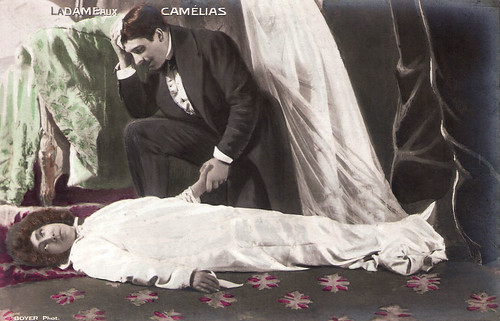
French postcard. Photo Boyer. Sarah Bernhardt debuted in Alexandre Dumas fils's play 'La Dame aux Camélias' in 1880. It became one of her most beloved and most performed plays. In 1911, Bernhardt would act in a silent film version as well, La Dame aux Camélias directed by André Calmettes and Henri Pouctal. This postcard is from the early 20th century. The card depicts the dead Marguerite Gauthier, deplored by her lover Armand Duval.

Italian postcard by Ed. Vettori, Bologna. Francesca Bertini (Marguerite Gauthier) and Gustavo Serena (Armand Duval) in the film La signora delle camelie/The lady of the Camellias (Gustavo Serena, 1915).

German postcard by Photochemie, Berlin, no. K. 1994. Photo: Union Film. Erna Morena and Wilhelm Diegelmann in Prima Vera (Paul Leni, 1917), based on Alexandre Dumas fils's novel and play 'La dame aux camélias'.

Italian postcard by G.B. Falci, Milano, no. 326. Photo: Esclusiva S.A. Stefano Pittaluga. Norma Talmadge in Camille (Fred Niblo, 1926), produced by Talmadge's own film company and distributed by First National. The film was based on the often filmed novel and stage play 'La Dame aux Camélias' (The Lady of the Camellias). Stefano Pittaluga distributed the film in Italy. The man next to Talmadge is Oscar Beregi, who plays the Count.

British Art Photo postcard, no. 126. Photo: Metro-Goldwyn-Mayer. Greta Garbo and Robert Taylor in Camille (George Cukor, 1936).
One of the founders of the social drama
Alexandre Dumas fils was born in Paris in 1824. He was the illegitimate son of the better-known eponymous father, Alexandre Dumas, and Marie-Catherine Labay. However, he was recognised by his father as a legitimate son in 1831.
At the age of 17, after leaving the Collège Bourbon, Dumas embarked on a career as a writer with the poetry collection 'Péchés de jeunesse' (Sins of Youth). He accompanied his father on his journey through Spain and North Africa and, on his return, published the six-volume novel 'Histoire de quatre femmes et d'un perroquet' (1847), which aroused the curiosity of the public.
In the novel 'La dame aux camélias' (The Lady of the Camellias, 1848), Dumas realistically tells the story of a Parisian courtesan who dies early of consumption. It became his breakthrough. In the two later plays 'Diane de Lys' (1853) and 'Le demi-monde' (1855), the poet treats almost the same theme, but with much more satirical intent and more to hold up a mirror in the manner of the comedy poet of his time.
Dumas is considered one of the founders of social drama and he dealt with social and societal problems in almost all his plays. The position of women played a special role in this. He dealt with the rights and duties of women and the errors of the relevant legislation and social views in the novel 'L'affaire Clémenceau' (1864) as well as in several pamphlets such as 'Lettres sur les choses du jour', 'L'homme-femme', 'Tue-la! Les femmes qui tuent et les femmes qui votent '(1872-1880) and in the larger pamphlet 'Le divorce' (1880).
In 1875 Dumas was admitted to the Académie française, and in 1894 he became a member of the Legion of Honour. Considered unassuming and helpful to his friends, Dumas enjoyed general personal popularity. In 1864 he married Nadezhda Naryshkina of Knorring (1826-1895), with whom he had two daughters. After Naryshkina's death in 1895, he married Henriette Régnier de La Brière. Alexandre Dumas fils died in Marly-le-Roi, in 1895 at the age of 71. He is buried at the Cimetière de Montmartre in Paris.
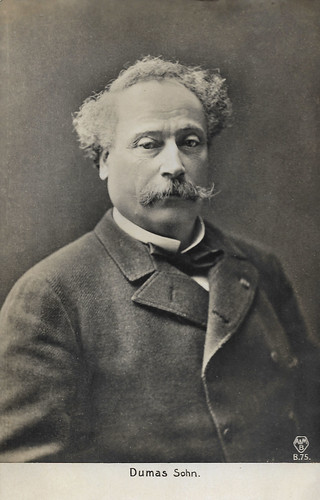
German postcard by A & M, B, no. B.75. Alexandre Dumas fils.

French postcard by Croissant, Paris, no. 1530/8. Photo P. Boyer. Sarah Bernhardt in La dame aux camélias (André Calmettes, Louis Mercanton, 1912). The film was priced by Le Film d'Art and distributed by Pathe Freres. Caption: Sleep in peace, Marguerite! Much will be pardoned to you, because you have loved so much!

German postcard by Photochemie, Berlin, no. K. 1982. Photo: Union Film. Erna Morena in Prima Vera (Paul Leni, 1917), based on Alexandre Dumas fils's novel and play 'La dame aux camélias'.

Spanish postcard by Amatller Marca Luna chocolate, series 2a, no. 24. Photo: Caesar Film. Francesca Bertini and Gustavo Serena in Il processo Clémenceau/The Clemenceau Affair (Alfredo De Antoni, 1917). In Spain the film was released as 'El proceso Clemenceau'.

Spanish collectors card in the Colec. cromos cinematográficos by Chocolat Imperiale, no. 4 (in a serie of 6 cromos). Photo: Tiber-Film, Roma / J. Verdaguer, Barcelona. Hesperia in La principessa di Bagdad/The Princess of Bagdad (Baldassarre Negroni, 1918).

Spanish collectors card in the Colec. cromos cinematográficos by Chocolat Imperiale, no. 6 (in a serie of 6 cromos). Photo: Tiber-Film, Roma / J. Verdaguer, Barcelona. Hesperia and André Habay in La principessa di Bagdad/The Princess of Bagdad (Baldassarre Negroni, 1918).

Italian postcard, no. 3033. Photo: Itala. Pina Menichelli and Vittorio Rossi-Pianelli in La moglie di Claudio (Gero Zambuto, 1918), based on 'La femme de Claude' by Alexandre Dumas fils. The film was found and restored in 2011 by Museo nazionale del cinema in Turin and Cineteca di Bologna. It was digitised in 2017.
The fate of a Parisian courtesan and her suitor
Alexandre Dumas fils' best-known work is the 1848 novel 'La Dame aux Camélias' (The Lady of the Camellias), which depicts the fate of a Parisian courtesan and her suitor. Despite difficulties with the censors, the novel was an extraordinary success.
After the work was reworked into a stage play, its popularity grew even more: first performed in 1852 at the Théâtre du Vaudeville, the work saw more than 100 performances without interruption. In 1853, Giuseppe Verdi adopted the theme for his opera 'La Traviata.
The French actress Sarah Bernhardt played the Lady of the Camellias in the play from 1880 onwards and enjoyed great success in Europe and the USA. The play was distinguished by its extremely sharp observation of social conditions, confident treatment of dramatic form, and lively, sparkling dialogue; but according to the view of the time, the glorification and rehabilitation of vice were morally questionable.
In 1911, Dumas's 'Lady of the Camellias' was first filmed with Vittoria Lepanto in 1909. Then followed La Dame aux Camélias/The Lady of the Camellias (André Calmettes, Henri Pouctal, 1911), starring Sarah Bernhardt. In Italy, it became one of Francesca Bertini's best roles in La signora delle camelie (Gustavo Serena, 1915). Bertini's rival Hesperia made that same year a competing version, La signora delle camelie, directed by Baldassarre Negroni. In another silent film version, Marguerite Gauthier was played by Clara Kimball Young (1915), Theda Bara (1917), Erna Morena (1917), Pola Negri (1920), Alla Nazimova (1921), Sybil Thorndike (1922), Tora Teje (1925), and Norma Talmadge (1926).
One of the best-remembered versions is Camille (George Cukor, 1937), in which Greta Garbo played the leading role of Marguerite Gauthier opposite Robert Taylor as Armand Duval. In other sound versions Marguerite was played by Yvonne Printemps (1934), ;Micheline Presle (1953), Maria Felix (1954), Sara Montiel (1962), Isabelle Huppert (1981), and Teresa Stratas (1983).
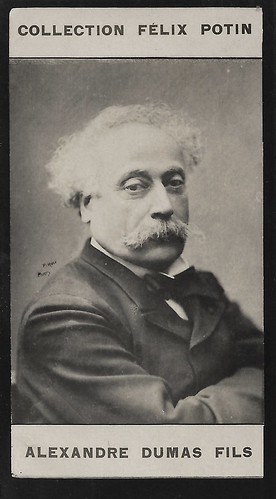
Vintage French minicard in the Collection Felix Potin. Photo: Eugène Pirou, Paris. Portrait of the writer Alexandre Dumas fils.
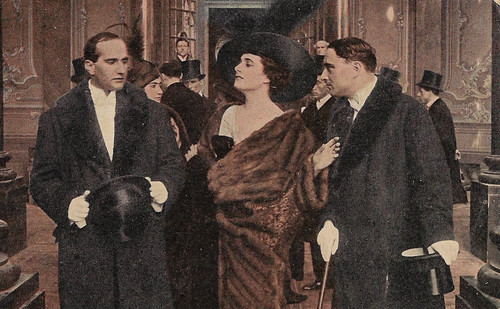
Spanish collectors card by Chocolate Pi, Barcelona, no. 1 of a series of 6 cards. Photo: Caesar Film. Francesca Bertini and Gustavo Serena in La signora delle camelie (Gustavo Serena, 1915), based on the stage play by Alexandre Dumas fils. The man on the right is Carlo Benetti.
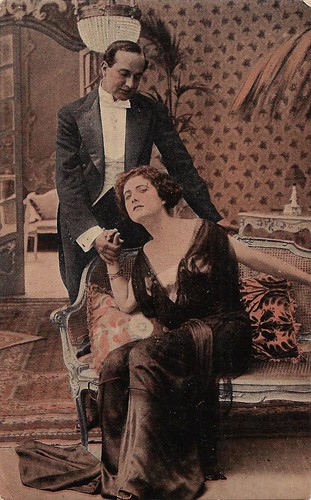
Spanish collectors card by Chocolate Pi, Barcelona, no. 2 of a series of 6 cards. Photo: Caesar Film. Francesca Bertini and Gustavo Serena in La signora delle camelie (Gustavo Serena, 1915), based on the stage play by Alexandre Dumas fils.
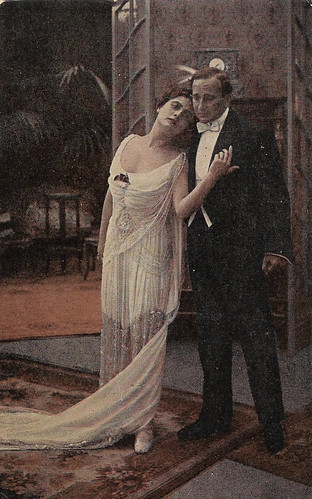
Spanish collectors card by Chocolate Pi, Barcelona, no. 3 of a series of 6 cards. Photo: Caesar Film. Francesca Bertini and Gustavo Serena in La signora delle camelie (Gustavo Serena, 1915), based on the stage play by Alexandre Dumas fils.

Spanish collectors card by Chocolate Pi, Barcelona, no. 4 of a series of 6 cards. Photo: Caesar Film. Francesca Bertini and probably Antonio Cruichi in La signora delle camelie (Gustavo Serena, 1915), based on the stage play by Alexandre Dumas fils. If this is the scene with Armand's father, then the Verdi operatic equivalent would be the aria of Germont: 'Di Provenza il mar, il suol'.

Spanish collectors card by Chocolate Pi, Barcelona, no. 5 of a series of 6 cards. Photo: Caesar Film. Francesca Bertini and Gustavo Serena in La signora delle camelie (Gustavo Serena, 1915), based on the stage play by Alexandre Dumas fils. The little rotund man on the right is Camillo De Riso. The man just left of Serena, looking at him, is Carlo Benetti. The woman whose head is partly covered by Bertini, is Olga Benetti.

Spanish collectors card by Chocolate Pi, Barcelona, no. 6 of a series of 6 cards. Photo: Caesar Film. Francesca Bertini in La signora delle camelie (Gustavo Serena, 1915), based on the stage play by Alexandre Dumas fils.

French postcard by J.R.P.R., Paris, no. 104. Photo: First National. Norma Talmadge in Camille (Fred Niblo, 1926). Produced by Joseph Schenk, the later producer of United Artists, and based on the famous novel by Alexandre Dumas fils.

German postcard by Ross Verlag, no. A 1330/1, 1937-1938, Photo: Metro-Goldwyn-Mayer. Greta Garbo and Robert Taylor in Camille (George Cukor, 1936).

German postcard by Ross Verlag, no. 831/1, 1925-1926. Photo: British American Films / Balag. Collection: Didier Hanson. Alla Nazimova and Rudolph Valentino in Camille (Ray C. Smallwood, 1921).
Sources: Wikipedia (German and Dutch), and IMDb.
No comments:
Post a Comment